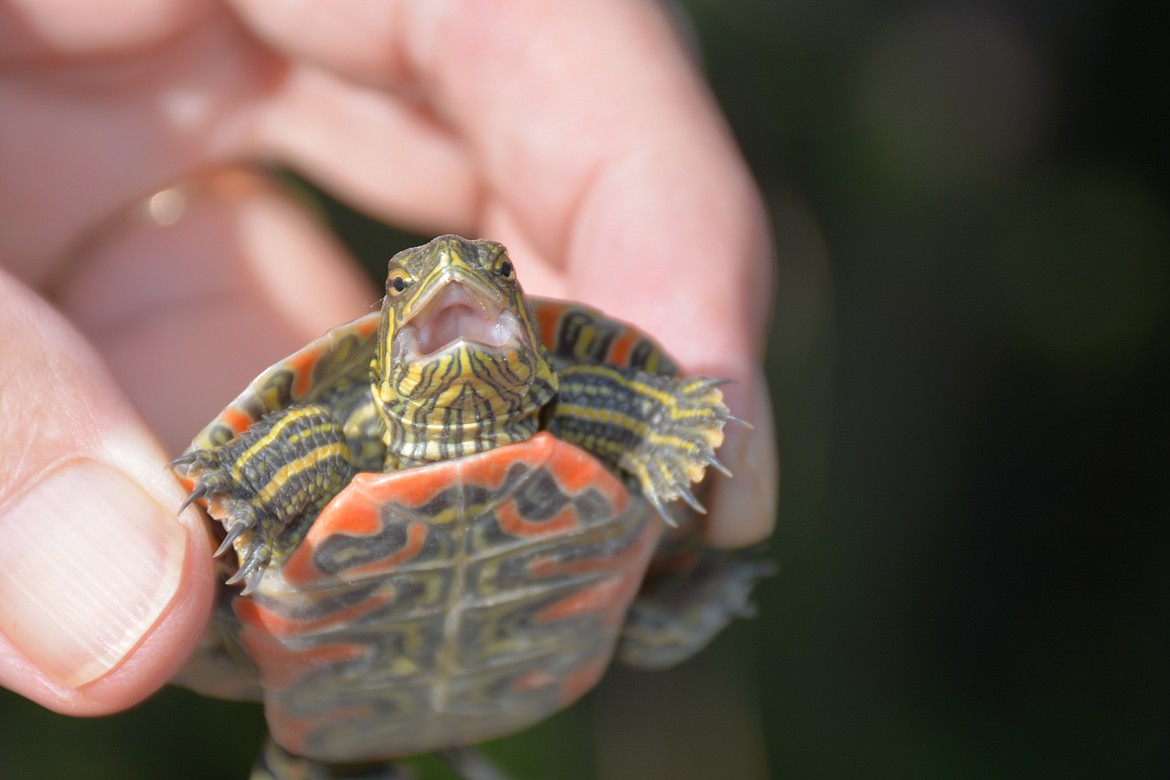Painted turtles: A colorful sight basking in the sun
In the spring and summer I enjoy the sighting of Painted Turtles basking on limbs and logs while floating on a pond or lake. I often stop to study them; they momentarily hesitate then jump into the water and disappear only to come back later and resume their place in the sun.
About a week ago while traveling a gravel road beside a Boundary County creek a baby Painted Turtle caught my eye at the edge of the road so I stopped to observe it. Upon picking him up he seemed to be saying in his youthful way, “I am going on a mission and I can’t be detained”! So I placed him in the gravel and he went scurrying down the bank and toward the creek. Baby turtles are independent after hatching and they instinctively head to water and he was no exception.
The Painted Turtle is the only species of turtle that occurs naturally in Idaho so identifying them should be easy. However, due to escaped pets and introduced species, one must become familiar with the general characteristics of Painted Turtles to avoid confusing them with such turtles as Box Turtles, and Red-eared Sliders (both are common pet species). Painted turtles are easily recognizable, their plastron (lower shell), neck and limbs are so brightly colored with yellow or red lines and markings that the common name seems very appropriate.
The most widely distributed turtles in North America are found in freshwater ponds, lakes, rivers and streams throughout the continent. There are four subspecies of painted turtles: eastern, midland, southern and western. Their ranges overlap, and they can interbreed. Interbred offspring are called intergrades.
The painted turtle is largely aquatic, living in shallow water habits, and is among the most conspicuous of the basking turtles. Painted turtles are medium-sized turtles approximately 4-7 inches. Males are smaller than females. In general, the shell comprises approximately 30 percent of the total wet weight of the painted turtle.
Painted turtles habitat includes soft and muddy bottoms, basking sites, and aquatic vegetation. They prefer slow-moving shallow water such as ponds, marshes, ditches, prairie sloughs, spring runs and canals. They desire areas with floating surface vegetation for feeding and for cover.
Painted turtles are omnivorous and depending on the habitat and on age, painted turtles may consume predominantly vegetation or animal matter. They are diurnal and usually spend their nights sleeping submerged. During the day, they forage in the late morning and late afternoon and bask during the rest of the day.
Mating starts after hibernation and before feeding begins when the water temperatures are still low. Environmental temperature determines when the sexes are ready to mate. The breeding season lasts from late spring to early summer and they only breed once a year. Males mature usually at 3-5 years and females take longer at 6-10 years of age.
In the early summer females lay 4 to 15 oval, soft-shelled eggs, in a flask-shaped hole. Females choose soft, sandy soil with good exposure to the sun in which to dig the hole. Once the eggs are laid they cover the hole and leave. The young hatch and dig out of the nest on their own, they are independent immediately.
Nests are often discovered by birds, raccoons and skunks, who make a meal of the eggs. Newly hatched turtles about the size of a quarter, are easy prey for birds, foxes, raccoons, skunks, and snakes and large fish. It’s not unusual for 90 percent of painted turtle eggs and babies to be lost to predators. Predators don’t normally bother adult turtles, but it’s possible for them to lose limbs if they’re attacked by predators on land.
Painted turtles may live as long as 35 to 40 years, but most will not survive for this long.
Explore Boundary County. Enjoy the outdoors!





